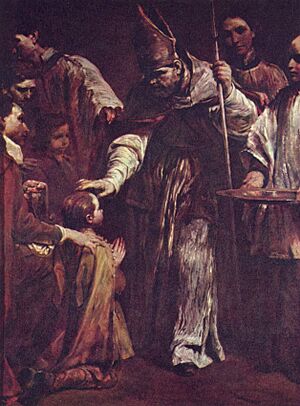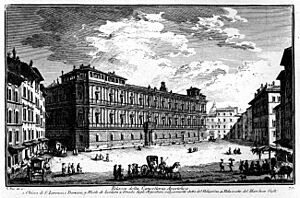Pietro Ottoboni (cardinal) facts for kids
Quick facts for kids Pietro Ottoboni |
|
|---|---|
| Cardinal-Bishop of Ostia e Velletri | |

Portrait by Francesco Trevisani
|
|
| Church | Catholic Church |
| Appointed | 14 June 1726 |
| Reign ended | 29 February 1740 |
| Other posts | Archpriest of the Archbasilica of Saint John Lateran Vice-Chancellor of the Holy Roman Church Secretary of the Roman Inquisition |
| Orders | |
| Ordination | 13 July 1724 (deacon) 14 July 1724 (priest) |
| Consecration | 4 February 1725 by Benedict XIII |
| Created Cardinal | 7 November 1689 |
| Rank | Cardinal-bishop |
| Personal details | |
| Born | 2 July 1667 Venice, Republic of Venice |
| Died | 29 February 1740 (aged 72) Rome, Papal States |
| Buried | San Lorenzo in Damaso |
| Previous post |
|
Pietro Ottoboni (born July 2, 1667 – died February 28, 1740) was an important Italian cardinal. He was the grandnephew of Pope Alexander VIII, who was also named Pietro Ottoboni. Cardinal Ottoboni is best known for being a huge supporter of music and art during his time. He was the last person to hold the special church job called cardinal-nephew. This role was ended by the next Pope, Pope Innocent XII, in 1692. People described Ottoboni as someone who "loved fancy things and spending a lot, but was also kind, helpful, and generous."
Contents
Early Life and Church Career
Pietro was born in Venice, Italy. His family, the Ottobonis, was a noble family. His great-uncle became Pope Alexander VIII (who was Pope from 1689 to 1691). The Ottoboni family became part of Venice's nobility after a battle in 1499. They later became very wealthy in the 1600s through diplomatic work.
Pietro started his church career on October 20, 1689. He became a cardinal deacon on November 7, 1689. Just a week later, on November 14, he was given the red hat, a symbol of a cardinal. On the same day, he was made Vice-Chancellor of the Holy Roman Church. He held this important job until he died. He also became the governor of cities like Fermo and Tivoli.
As he got older, he took on more important roles within the church. He became the cardinal-bishop of Sabina in 1725. Then, he was the cardinal-bishop of Frascati in 1730. In 1734, he became the cardinal-bishop of Porto and Santa Rufina. Finally, on September 3, 1738, he became the vice-dean and then the dean of the Sacred College of Cardinals. He was also the Archpriest of the Basilica of Saint Mary Major. He served as secretary of the Roman Inquisition and Archpriest of the Lateran Basilica starting in 1730.
Supporting the Arts
Cardinal Ottoboni was one of the most important supporters of artists and musicians of his time. He lived in the grand Palazzo della Cancelleria in Rome. He started building a theater there in 1689. Andrea Adami, who was a favorite of the Cardinal, became the leader of the papal choir in the Sistine Chapel. Between 1709 and 1710, the architect Filippo Juvarra joined Ottoboni's court. He helped make the theater even bigger. Domenico Paradisi and Angelo de Rossi were in charge of decorating the palace rooms.
Ottoboni strongly supported Arcangelo Corelli, who was the best violinist of his generation. Corelli played at Ottoboni's Monday night concerts, which were called "academies." When Corelli passed away in 1713, he left his belongings, including valuable paintings, to the Cardinal. Ottoboni then gave the money from Corelli's estate to Corelli's family. He also built a grand tomb for the musician in the Pantheon. Other famous artists who received support from the Cardinal included Alessandro Scarlatti, Antonio Vivaldi, and Antonio Caldara. Pietro Ottoboni, like his father Antonio Ottoboni, wrote words for songs (cantatas) and stories for operas (oratorios). For example, he wrote the story for Scarlatti's La Giuditta in 1693. When opera was not allowed in Rome, performances moved to Ottoboni's Cancelleria palace. In 1726, he returned to Venice, and his arrival was celebrated with music. This included a special performance called Andromeda liberata, with songs by various Venetian composers like Vivaldi.
The young architect Giovanni Battista Vaccarini and painters like Sebastiano Conca, Sebastiano Ricci, and Francesco Trevisani also benefited from his support. Trevisani lived at Ottoboni's court for almost 40 years. One of Ottoboni's most important art projects was the Seven Sacraments series. This was painted in 1712 by Giuseppe Maria Crespi and is now in the Museum of Dresden. In 1735, he gave his Roman sculptures and other ancient artworks to the Capitoline Museums. The last ten years of Ottoboni's life were his busiest as a patron of the arts.
Later Life and Legacy
When Pope Clement XII died on February 6, 1740, Ottoboni was considered a possible new Pope. However, he left the meeting to choose the new Pope because he had a fever. He died three days later. His family quickly took advantage of the Pope's position being empty. They removed everything they could from the Cancelleria palace. There is a detailed list of the Cardinal's paintings, showing where they were in each room. This list gives a clear idea of how many artworks he collected over 50 years. It mentions almost 530 paintings. Some of these were inherited from his great-uncle. Important painters included Benedetto Luti, Guido Reni, Giovanni Batista Gaulli, Tintoretto, Pusini, Giuseppe Chiari, Pietro da Cortona, Francesco Albani, Jacopo Bassano, Giovanni Baglione, Giacinto Brandi, Giuseppe Cesari, and Veronese. In Rome, Ottoboni also developed a liking for paintings from Northern Europe. These included works by artists like Caspar van Wittel and Gerrit van Honthorst. Ottoboni's belongings were sold in four different sales. Because of this, his collection was spread out all over the world. All his financial accounts were finally settled in 1752.
Financial Challenges and Dispersal of Collections
Even though Cardinal Ottoboni had many church benefits and was allied with the French king, he always spent more money than he earned. When he died, his belongings had to be sold to pay off his debts.
Ottoboni's large music library was also sold after his death. However, some of his music, known as the "Manchester Concerto Part-books," still exists. These books contain separate parts for 95 musical pieces, mostly concertos. His handwritten music scores later went to Charles Jennens, who wrote the words for Handel’s Messiah. The variety of music in this collection suggests that Ottoboni's musicians played music from other important art centers, like Venice and Bologna, as well as music composed in Rome.
Ottoboni was a talented writer of opera and oratorio stories. He was also a member of the Academy of Arcadia, a group of poets and writers. The famous writer Pietro Metastasio was his godchild.
See also
- Codices Ottoboniani in the Vatican Library



